
Back to Home
Getting and Enjoying Eggs
Eggs can come in pretty colors...

This can be the haul in 1 day from 20 hens. We started with Buff Orpingtons, and curiously the 9 hens each laid a slightly different tint of brown. I only got 9 eggs once from my 9 hens... usually it was 4-6 a day. I don't have any high-output breeds, because friendliness was a close second in importance for me.
The darker brown eggs on the left are from the Buckeye chickens. They are pretty uniform from 6 hens. The blue eggs are from so-called Easter Eggers. Those eggs are a pretty uniform shade of light green-blue. Just beautiful! A bit smaller than the Orp eggs, and not surprising considering the hens are a lot smaller...
...but they don't come year round.
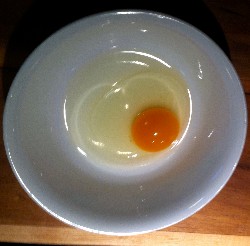
If you get chicks in May, they will start to lay mid- to late-October.
If you get them later, they will lay later. The eggs start out smaller and infrequent the first month or so.
The May hens will stop laying the following October, so they can molt.
Some thoughts on selling eggs
There are laws and regulations about selling eggs. The main reason our freedom is being impinged upon is the fact that society assumes your are buying from strangers. If you know the farmer, and you know the coop conditions and the health of the chickens and in short the reputation of the farmer, then you don't need laws to protect you.
Eggs are released from the cloaca, which also releases fecal matter. There are less pretty ways to say that, but rest assured that Mother Nature is aware of the problem. Eggs have a natural bloom, that prevents bacteria from accessing the inside of the shell. The eggshell is a nearly perfect container for a delicious treat. This is why I do not wash my eggs - I am relying on that bloom to protect the eggs. I don't want to disturb it by scrubbing and I don't want to wash the egg in harsh cleaning agents.
But this means a certain percentage of eggs are "just for the family" - they are not saleable because they have mud or crusted fecal matter on them. This happens despite certain precautions I take, such as closing the nest boxes at night (or the chickens will poop in them as they wake up in the morning). Sometimes they just can't hold it!
Conveniently, in OH we have regulations specifying that eggs sold direct to consumer by the farmer do not need to be registered with the Ohio Department of Agriculture and your kitchen doesn't need to be registered for food sale.
And all about eating eggs!
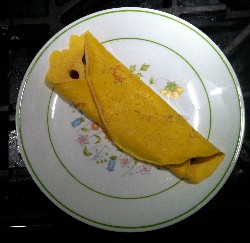
Eggs from free-ranging chickens - when they have access to greens and bugs, which is 10 months of the year in OH - look a little different from store eggs. The yolk is more orange, and stands up higher. I don't find a huge difference in taste, but others say the flavor is fuller and more satisfying. Gotta love it when customers say that!
I have to share our favorite egg recipe. It's for making crepes.
- Fast Crepes
- 1 egg
- 1/3 milk
- 1/4 cup or so of flour
- The bowl matters: find one with a wide base.
You're aiming for a consistency thicker than milk but thinner than pancake batter.
For smoother crepes, prepare batter 1/2 hour ahead of time. Generally I skip this...crepes with tiny flour lumps taste fine.
Butter a 10-12" pan. Heat the pan until you can swirl the butter to all corners.
Then pour the crepe mix in. Swirl so it covers the pan evenly with a thin coat.
Flip the crepe once the surface is no longer shiny (30 sec maybe).
After I flip it, I put on the fixings: jam, butter and sugar, chocolate chips, cheese...
Honestly (and ironically), I'm not a huge egg fan, when prepared as scrambled eggs. I don't like them unless they have lots of cheese. But when I am getting a dozen eggs a day, and not all of my customers need eggs that week, we have to eat eggs in self defense... so we eat crepes every morning. This is some serious brain food, which fuels our morning big time.
Breeds of Chickens
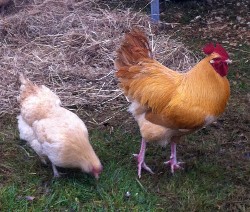
I have had 4 kinds of chickens. We ordered Buff Orpingtons through the mail. They grew to be large, stately birds and are indeed friendly. The roosters, on the other hand, are looking to be dominant over people. We ordered a straight run, meaning equal numbers of roos and hens, with 9 of each. We found half the roosters to be agressive to their own hens, and by October were left with one seemingly agreeable guy. Come May the following year, Big Bully Fatbutt had to go. He was not learning that people are top dog. He was so rough with the ladies that I had to make coats for them so he did not shred their skin the way their feathers were shredded.
The next year, we decided to try Silver Spangled Hamburg hens. The first year, we had gotten our Orps, and also one extra rooster - who turned out to be a Silver Spangled Hamburg with an unusual comb. He was small, and quite calm with people, even my 8 yr old son. The hens had a bad start - we lost half of them because their shipment was delayed. They were unbelieveably flighty, and after the winter, when their egg production did not come back well, we put them down. With a less stressed start, they may have been much better, but they would never be as calm as Orps.
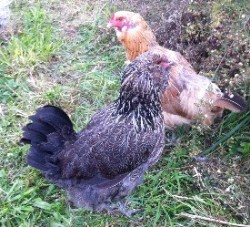
The third year, we got Easter Eggers and Buckeyes. The Easter Egger roosters were not calm enough but nowhere near as aggressive as the Orpington roos. The hens fairly calm and friendly, but not as much as the Buff Orp hens. It's hard to tell if there is a genuine difference because we did not spend as much time with the Buckeye and Easter Eggs as chicks. By the third year of owning chickens, it was a chore to get the kids to spend time with the chicks! The Buckeyes seemed to molt before the Easter Eggers, which is kind of convenient.
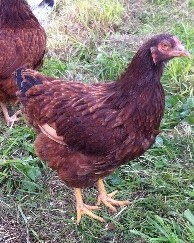
One note about managing for constant egg production in areas that have Winter: the breed matters, and if you don't get new chicks every year, you won't have year-round eggs. In OH, hens that were born in late April will start to lay in early Nov. Hens that are over a year old will molt in Oct-Nov, and will stop laying for 2-4 months. This is a long time to go without eggs!
Another note about managing your egg production: a light in the coop to get the day length to be 12 hours has worked pretty well for us to get winter egg laying going on. We set the timer to start early in the AM, around 5, since the sun set around 5. Some of this will depend on the breed - the Orpington hens laid pretty well their first year without a light, the Silver Spangled hens did not lay in the winter despite the light, and the Easter Eggers and Buckeyes lay well their first winter with a light starting in early December. We used a work light with an incandescent - not fluorescent, wrong wavelengths for the hens - on a cheap backyard timer.
Coop Thoughts
coming soon...
Chickens in your Yard and Life
coming soon...
Chickens and the Soup Pot
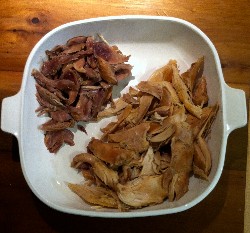
We harvest our own chickens. We choose to purchase straight run chicks and then we cull the roosters at 4-5 months of age. I think the description in Harvey Ussery's book is very clear. There are lots of videos and websites with instructions; for the record, we skin our birds because plucking is a marriage-breaker. We also choose to cull our non-productive hens at a convenient time for us. We get delicious stock as well as flavorful meat, but it is not as versitile as the meat from Cornish Crosses we get from the grocery store. The meat is tasty and tender ONLY when it is slow cooked in our crock pot and used in soup or casserole-type sauce dishes. I like shredding the slow-cooked meat and spicing it for tacos, or tossing with cooked noodles browned in butter, broccoli, little bit of parmesan cheese, and maybe 1/4 c heavy cream.
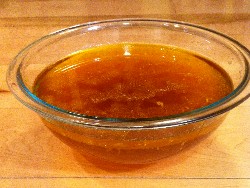
I am not keeping chickens as pets, but by the same token I want to honor them as their own creatures. When we get unwanted roosters as chicks, if they can't live harmoniously with our favorite rooseter, then they are humanely culled and then processed in the backyard. No pictures here! But I will share a few details about how our homestead manages this part of owning chickens.
Processing: Here is a link on humanely ending a chickens' life. We get them out of the coop the night before and keep 2-4 in a pet carrier (depending on the size of the chicken and the carrier). That way they are calm first thing the next morning - no chasing them around the yard - and they have not eaten, so their crop is empty. After they are culled and bled (upside down in a trash can lined with a bag), we skin them.
Store chickens are a hybrid, a cross between Cornish and Plymouth Rock breeds. The exact details about which is the hen, which the rooster, etc, are trade secrets. The Cornish Cross chickens almost seem like they have giantism, since they get to 4-5 lbs by 2 months of age, and thus they require careful managing. They seem to be dim-witted too, and so I have never wanted the extra work they seem to need. But because they are harvested at 2 months old, they are very tender. A backyard breed is at maybe 2 lbs by 2 months, and is more bone and feathers than flesh. By the time they are full sized, well, it's coq au vin time - or crock pot time.